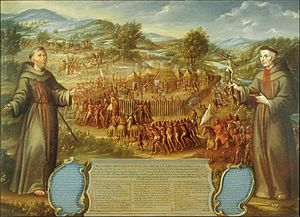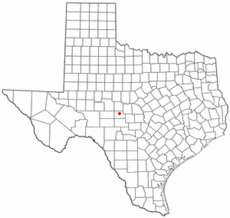Mission Santa Cruz de San Sabá facts for kids

The Mission Santa Cruz de San Sabá was an important Spanish mission built in Spanish Texas. It was started in April 1757. The mission was located near the San Saba River in what is now Menard County. Its main goal was to teach the Lipan Apache tribe about Christianity. A fort, called the Presidio San Luis de las Amarillas (later Presidio of San Sabá), was built nearby to protect the mission.
Even though no Apache people ever lived at the mission, other tribes saw it differently. The Comanche tribe, who were enemies of the Apache, thought the Spanish were helping the Apache. In 1758, about 2,000 warriors from the Comanche, Tonkawa, Yojuane, Bidai, and Hasinai tribes attacked. They completely destroyed the mission. This was the only Spanish mission in Texas to be fully destroyed by Native Americans. The nearby fort was not attacked.
To get back at the attackers, the Spanish government sent an army in 1759. Colonel Diego Ortiz Parrilla led over 500 Spanish soldiers and Apache fighters. They went into Comanche lands. Near the Red River, they found a Wichita village. This village was well-protected with a moat and a wooden fence. The Native Americans tricked Ortiz's soldiers into a trap. After a four-hour battle, the Spanish lost 19 soldiers and had to retreat. They even left two cannons behind.
Years later, in 1762, a special painting was ordered to remember the mission's destruction. This painting, finished in 1765, was the first artwork to show a historical event in Spanish Texas. Today, a historical marker stands near where the mission once was. Archaeologists also explored the site in the 1990s to learn more about its past.
Contents
Why the Mission Was Built
In 1716, Spain decided to settle the area known as Spanish Texas. They wanted to stop French traders and missionaries from gaining too much power in nearby Louisiana. Over the next few years, Spanish missionaries built several Spanish missions in Texas. These missions mostly served the Hasinai and Coahuiltecan tribes. By 1731, many missions moved to the San Antonio River. The number of Spanish soldiers in Texas was also reduced.
Spain had strict rules about trade. They wanted their colonists to only trade with Spain. Goods for Texas had to travel a long way from Veracruz to San Antonio. This made things very expensive and hard to get. It was difficult for settlers and missionaries to trade with or give gifts to local tribes.
Native American tribes, however, traded freely. Some tribes got French guns, while others traded for or stole Spanish horses. Tribes without these resources were at a disadvantage. The Lipan Apache, who used to farm, were pushed by the Comanche (who had horses) and the Wichita (who had guns). The Apache were old enemies of the Hasinai tribes. They started to see the Spanish as enemies too, because the Spanish were friends with the Hasinai. For many years, the Apache often raided Spanish settlements.
The Apache also raided other tribes, like the Deadose and Tonkawa. In the 1740s, these weaker tribes asked for missions along the San Gabriel River. They hoped the Spanish could protect them. Mission San Francisco Xavier was built in 1746. It was meant for the Deadose, Mayeye, and Coco Indians. But the Apache raided this mission four times in 1748 alone. Many Native Americans living there left because of the danger. Despite this, missionaries built two more missions nearby the next year. However, by 1755, these missions moved to the San Marcos River.
Planning the San Sabá Mission
In August 1749, the Apache and Spanish made a peace agreement. The Apache then started asking for Spanish missions. Spanish leaders were careful about these requests. They worried the Apache just wanted Spanish help to fight the Comanche. However, the Spanish also thought that if they could make the Apache peaceful, they could expand their missions north. A large peaceful area could help them create a land route to Santa Fe.
In 1752, Spanish leaders approved a trip to explore Apache lands. They wanted to find a good spot for a mission. The next year, a small group, including Father Miguel de Aranda, explored areas northwest of San Antonio. They looked at the Pedernales River, the Llano River, and the San Saba River. The San Saba River area looked the best. The soil was good, there seemed to be minerals, and local Apache promised to come to a mission. The explorers suggested building a mission there. They also said a fort should be built nearby to protect it from the Comanche.
The viceroy (a high-ranking Spanish official) ordered another trip in 1754. Former Texas governor Pedro de Rábago y Terán explored the same area. He agreed with the earlier suggestion. People in San Antonio were excited. They hoped a new northern settlement would protect their town from raids. The governor still waited. In 1756, he asked Lieutenant Governor Bernardo de Miranda to explore the area again. Miranda heard rumors from the Apache about silver near San Sabá. He also recommended the area.
Finally, in 1757, the mission was approved. For three years, a local mine owner named Pedro Romero de Terreros would pay for the mission. His cousin, Father Alonso Giraldo de Terreros, would lead the mission. After three years, the government would take over the costs. The government would also pay for the soldiers at the fort. The missions along the San Marcos River were closed. Their supplies were bought by Pedro Terreros and moved to the new mission. This mission was special because it reported directly to the viceroy, not the local governor.
Franciscan missionaries from two colleges were assigned to the mission. A fort was also approved to protect the mission and its people. The missionaries worried that soldiers might be a bad influence on the new converts. They insisted the fort be built 3 miles (4.8 km) away and on the other side of the river. There were some disagreements among the missionaries. Some supported Father Terreros, while others were upset he was chosen over priests who had worked longer with the Apache. Colonel Ortiz Parrilla, the fort's commander, also doubted Father Terreros's leadership and the Apache's true intentions. He delayed the journey several times.
In April 1757, the missionaries, soldiers, and their families left San Antonio for the San Saba River. They brought many animals, including 1,400 cattle and 700 sheep.
When they arrived, no Apache were waiting at the mission site. After five days of searching, Ortiz could not find any Apache. Ortiz wanted to stop the mission, but the six missionaries refused to leave. The mission was built near what is now Menard. The Presidio San Luis de las Amarillas (fort) was built at the same time. It was on the other side of the river, 3 miles away, as the priests wanted. Apache representatives sometimes visited the mission. They promised to move there soon, but none ever did. Three of the six missionaries eventually returned to San Antonio.
The Mission's Destruction
The presence of the San Sabá mission made Comanche leaders very angry. They saw it as proof that the Spanish were friends with the Apache. They also felt it was an invasion of their land. The Apache made this idea stronger. They would leave Spanish items, like shoes, behind when they raided Comanche camps.
Soon, the fort's soldiers heard rumors that hundreds of Comanche warriors were heading towards the mission. Ortiz asked the missionaries to move into the fort for safety, but they said no. Because many women and children lived in the fort, Ortiz could only send a few soldiers to stay at the mission with the priests.
The Comanche joined forces with other tribes who were traditional enemies of the Apache. These included the Tonkawa and Hasinai. On March 16, 1758, this large group of about 2,000 warriors attacked the mission. Spanish reports said that at least half of the warriors had European guns. This was unusual at a time when most Native Americans fought with bows, arrows, or hatchets.
Eight people died in the attack, including Father Terreros. The mission was completely burned down. Almost every animal at the mission, including the cattle, was killed. One missionary and about 20 other people managed to escape to the nearby fort. The Comanche gathered near the fort. They tried to trick the soldiers into coming outside the safety of the wooden walls. When their tricks didn't work, the Native Americans left on March 18. The San Sabá mission was the only Spanish mission in Texas to be totally destroyed by a Native American attack.
What Happened Next
This event showed that the French had become very influential with the Comanche and other northern tribes. These tribes had learned European-style fighting methods. Many Spanish officials believed the French had caused the attack. They thought the French had helped the Comanche prepare. However, historian David Weber says there isn't clear proof of this.
Because the Comanche had more fighters and similar weapons to the Spanish, many Spanish soldiers became afraid. Several soldiers at the San Sabá fort asked to be moved. The commander of another fort wrote that "The enemy [is] so superior ... in firearms as well as in numbers, that our destruction seems probable." Spanish officials refused to close the San Sabá fort. They ordered it rebuilt with strong limestone walls and a moat. They also increased the number of soldiers to 100. For the next ten years, Comanche forces stayed nearby. They would kill soldiers who left the fort in small groups.
In July 1767, the Marqués de Rubí visited San Sabá during his inspection of forts. Rubí and his engineer decided the fort was "of no advantage whatever." In 1769, the fort was moved to San Fernando de Austria (today's Zaragoza), about 250 mi (400 km) south near the Rio Grande. For many years after this, the Spanish did not try much to explore or settle in Comanche territory.
In 1762, Pedro Romero de Terreros ordered a painting to honor his cousin who died in the attack. The painting, called The Destruction of Mission San Sabá in the Province of Texas and the Martyrdom of the Fathers Alonso Giraldo de Terreros, Joseph Santiesteban, is the earliest known painting to show a historical event in Texas. According to the Handbook of Texas, it is "the only such work executed in Mexico in the mid-1700s that attempted to document a contemporary historical event." The painting caused some discussion in the 1980s. United States Customs agents took it in Texas and returned it to Mexico.
In 1936, a historical monument was placed at a spot believed to be the mission grounds. In 1965, archaeologists started looking for the exact mission site. In 1993, they began digging about 1 mile (1.6 km) from the monument. They found over 300 Spanish artifacts.
See also
- San Sabá fight (1831)


